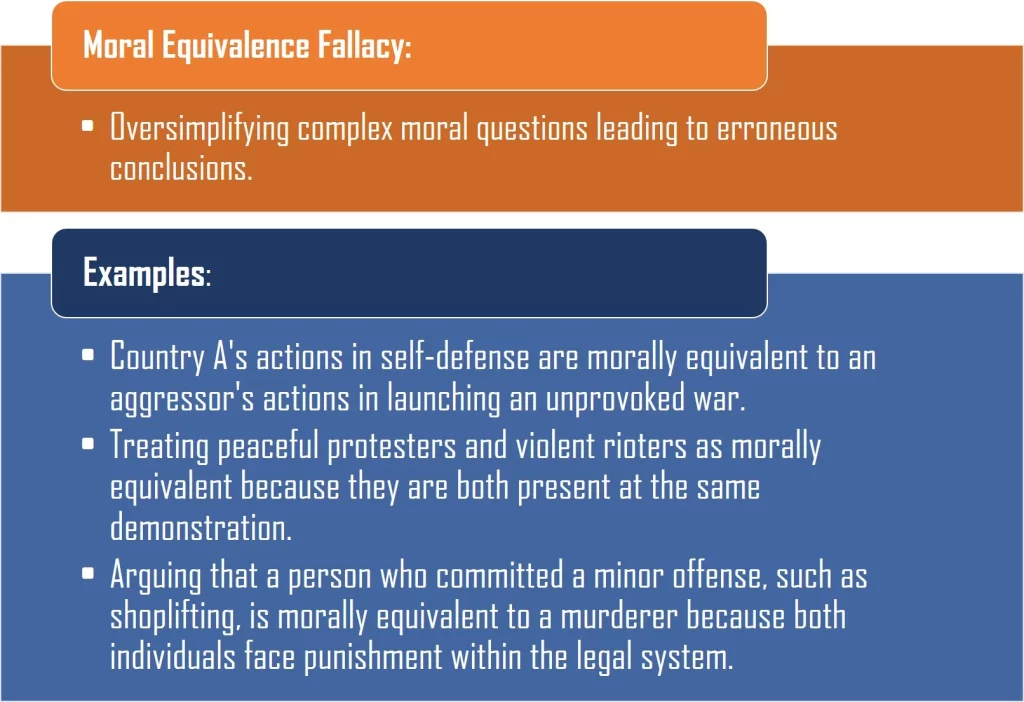- 5-Paragraph Argumentative Essay on Euthanasia
- Aristotelian Argument Essay on Marijuana
- Toulmin Argument Essay on Artificial Intelligence
- Rogerian Argument Essay on Gun Control
- Rebuttal Argument Essay on Renewable Energy
- Sample Historical Argument Essay on the Industrial Revolution
- Literary Argument Essay on 'The Cask of Amontillado'
- Persuasive Argument Essay: Financial Literacy
- Persuasive Argument Essay: Social Media and Politics
- Proposal Argument Essay on Reusable Containers
- Proposal Argument Essay on Workplace Wellness
- Rhetorical Evaluation Argument Essay: MLK's "I Have a Dream"
- Literary Evaluative Argument Essay: "To Kill a Mockingbird"
- Narrative Argument Essay on Resilience
- Definition Argument Essay on Privacy
- Causal Argument Essay on Education

The moral equivalence fallacy, also known as false equivalence, occurs when two distinct actions or situations are considered to be morally equal or equivalent when, in fact, they are not. It involves comparing two things that differ significantly in terms of their moral implications, severity, or consequences, and treating them as if they are equally wrong or right. It is a type of ethical/moral fallacy.
Recap on Fallacies in Arguments
Identifying Moral Equivalence Fallacy in Arguments
- Comparison of dissimilar actions or situations: The fallacy involves comparing two actions or situations that are fundamentally different in terms of their moral implications, severity, or consequences. Pay attention to whether the actions being compared are truly comparable or if they involve distinct contexts, degrees of harm, or moral considerations.
- Ignoring relevant differences: The fallacy overlooks or downplays significant distinctions between the actions or situations being compared. It fails to acknowledge key factors that contribute to the moral assessment of each action, such as intent, scale, consequences, or underlying principles.
- Oversimplification: The fallacy oversimplifies complex moral issues by treating them as if they have the same moral weight or significance. It ignores the nuances and complexities of the ethical considerations involved in order to draw a false equivalency.
- Disregard for context: The fallacy ignores the specific context, circumstances, or specificities of the actions being compared. It fails to account for the different factors that might influence the moral evaluation of each action or situation.
- Lack of proportionality: The fallacy fails to recognize and account for the varying degrees of moral seriousness or consequences associated with the actions being compared. It treats actions that may differ significantly in terms of harm, impact, or violation of ethical principles as if they are equally wrong or right.
- By being aware of these characteristics and carefully examining the reasoning behind the comparison, you can identify instances of moral equivalence fallacy and better evaluate the moral assessments being made in an argument.
Examples Illustrating Moral Equivalence Fallacy in Arguments
- Vandalizing public property is just as bad as corporate fraud.
In this example, Person A commits the moral equivalence fallacy by asserting that vandalizing public property and corporate fraud are equally morally wrong. However, Person B recognizes that these actions have different moral implications, severity, and consequences.
Corporate fraud has broader and more significant societal impacts, potentially affecting many individuals, whereas vandalism typically has more localized and limited effects. - Lying about your age on a dating profile is just as morally wrong as cheating on your spouse.
In this example, Person A commits the moral equivalence fallacy by asserting that lying about one’s age on a dating profile is morally equivalent to cheating on a spouse. Person B counters this fallacy by highlighting the significant differences in terms of the harm caused and the impact on relationships.
While both actions involve deception, cheating on a spouse involves a profound betrayal of trust within a committed partnership, potentially leading to the breakdown of the relationship and emotional distress for those involved. Lying about one’s age on a dating profile, on the other hand, may involve minor misrepresentation but does not typically result in the same level of emotional harm or relational damage. - Protesting against racial injustice is just as morally wrong as engaging in violent riots.
In this example, Person A commits the moral equivalence fallacy by asserting that protesting against racial injustice and engaging in violent riots are morally equivalent. Person B counters this fallacy by highlighting the significant differences between the two actions.
Peaceful protests, aimed at addressing systemic injustices, are protected forms of expression and have the potential to bring about positive social change. Violent riots, however, involve unlawful and destructive behavior that causes harm to individuals and communities, often overshadowing the underlying cause and undermining the effectiveness of peaceful protests. - Eating meat is just as morally wrong as killing humans.
In this example, Person A commits the moral equivalence fallacy by asserting that eating meat and killing humans are morally equivalent actions. Person B points out that there are significant differences in terms of the moral status attributed to human life compared to the lives of animals.
While taking the life of a human being is generally considered an egregious violation, the ethical considerations surrounding the consumption of meat are more nuanced and involve a broader range of factors. - Shoplifting a small item from a store is just as morally wrong as corporate embezzlement.
In this example, Person A commits the moral equivalence fallacy by asserting that shoplifting a small item and corporate embezzlement are morally equivalent. Person B counters this fallacy by highlighting the significant differences in terms of the scale, intent, and consequences of the actions.
Corporate embezzlement involves a more sophisticated and deliberate manipulation of financial systems, resulting in substantial harm to individuals and organizations. Shoplifting, although still morally wrong, typically involves minor theft that has limited impact.
- By recognizing the distinctions in moral significance and the value attributed to different forms of life, we can avoid falling into the moral equivalence fallacy and engage in more informed ethical discussions.
- Remember, classifications of fallacies in arguments are not exclusive.
